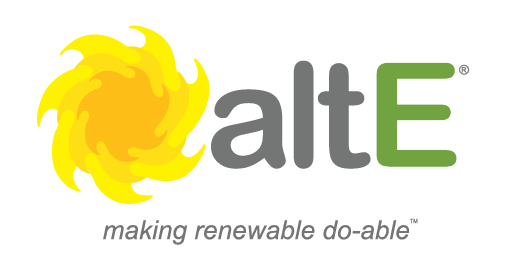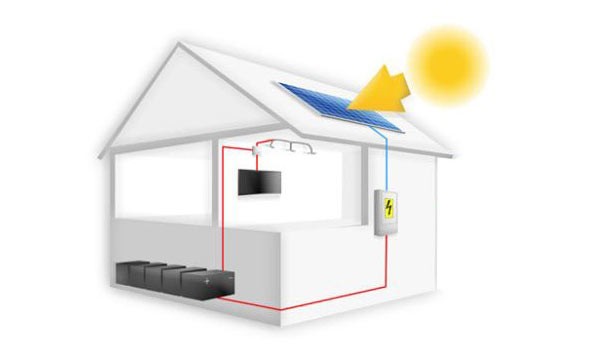Are you considering installing an off-grid solar power system? We’re taking a closer look at the components of off-grid solar systems, breaking down the purpose of each piece and helping you better understand what you’ll need to get started.
What is an Off-Grid Solar Power System?
First, a brief review of what off-grid solar power systems are and how they function:
An off-grid solar system is what its name suggests – a solar energy system that provides freedom from the utility grid. Because this type of solar system has no connection to the grid, it must be equipped with the necessary components to generate and store all of the electricity you need to power your home.
Off-grid solar is an ideal option for small and mid-sized homes and vacation properties, cabins, and similar structures, but not usually suited for properties with high energy demands (such as commercial buildings).
What Components Are Used in an Off-Grid Solar Power System?
The main components of an off-grid solar power system are:
Solar Panels
Solar panels are the most recognizable part of any solar energy system. They are also called photovoltaic (PV) panels because they use the photovoltaic effect to convert energy from sunlight into usable electricity.
There are three main types of solar panels: monocrystalline, polycrystalline (or multi-crystalline), and thin-film. All three types are made up of a collection of individual solar cells (the distinct square shapes visible on the front of the panel). Most solar panels available today are made up of either 60 or 72 cells (sometimes labeled as 120 or 144 “half-cut” cells). There isn’t much difference in performance between the three solar panel types, so choosing the best solar panels for an off-grid system is a matter of personal preference about how they look and their power output rating (in Watts).
The solar panels are physically mounted on a solar panel mount structure, and the DC power they produce is wired through the charge controller before it goes on to the battery bank, where it is stored.
See our Intro to Solar Panels video series for more detailed information on solar modules.
Charge Controller(s)
A charge controller manages the energy flow between the solar panels and the battery.
The two main functions of a charge controller are to:
- Prevent the battery from being overcharged
- Eliminate any reverse current flow from the batteries back to the solar modules at night
There are two types of charge controllers:
- MPPT (Maximum Power Point Tracking)
- PWM (Pulse Width Modulation)
PWM Solar Charge Controllers
PWM solar charge controllers rely on pulse modulation to adjust the rate at which energy is being sent from the panels to the battery. There is limited input available with PWMs compared to MPPT controllers and not as much control over power management. If you decide to go with PWM controllers, ensure that the nominal voltage levels of the batteries and panels match. (For example, if you have 12-volt panels, your battery bank also needs to be 12 volts).
MPPT Solar Charge Controllers
MPPT solar charge controllers are generally considered more efficient than PWM controllers. MPPT controllers track the maximum power point from the panels, set the output voltage to match the batteries’ charging voltage requirements, then maximize the current available at that voltage for battery charging. They can convert a higher voltage/lower current input to a lower voltage/higher current output without requiring additional power, making MPPTs the more efficient solar charge controllers – especially when using solar panels and batteries of different voltages. One of the most notable advantages of MPPTs is that they can capture the highest amount of power from a panel at any given moment, unlike PWMs with their limited input. MPPT controllers tend to be the controller type of choice for off-grid solar energy systems.
Learn more about how charge controllers work and their functions and features.
Inverter(s)
The inverter takes the DC energy stored in the battery bank and converts it to 120V or 240V AC electricity to run your AC appliances. There is a battery-based inverter in most off-grid solar power setups.
Inverters of different sizes can accommodate varying power loads, so you’ll need to select the option that aligns with your off-grid load requirements. Also, consider the total energy when all system loads are running simultaneously, as well as load spikes for temporary situations like refrigerator cycles and running power tools. When selecting an inverter, be sure its continuous power and peak/surge power rating (in Watts) exceed your electricity demands.
Additionally, the inverter’s voltage needs to match the system where it will be used. So, as an example: a 12-volt inverter is not compatible with a 24-volt battery bank. Instead, you’ll need a 24-volt inverter. Adjusting the voltage on an inverter is not an option, so you’ll want to be sure to purchase one with the correct voltage to match your battery bank. Be aware of the potential to expand your system in the future and buy accordingly.
Many off-grid systems utilize an inverter/charger. This type of inverter combines the functionality of a typical inverter with battery charging capabilities. So the inverter has both an output and an input. Why does this matter? With an inverter/charger, you gain the ability to incorporate an external power source (such as a generator) for powering the system loads. In simplest terms, an inverter/charger streamlines the battery charging process in a way that will benefit you on lower-production (cloudy) days.
Deep-Cycle Batteries
One or more deep-cycle batteries stores the energy produced by the solar array during the day for use at any time of the day or night. These batteries – different from car batteries – come in different capacities and voltages, and you can expect your solar battery to be one of the pricier pieces of solar equipment you purchase.
There are two primary battery chemistries used to store solar energy, each of which is used to make varying battery types:
Lead-Acid Deep-Cycle Batteries
Flooded lead-acid batteries are usually the most cost-effective option up-front, but maintenance is needed to extend their lifespan. Ventilation for flooded lead-acid batteries is crucial because hazardous off-gassing can occur in certain conditions.
Sealed lead-acid batteries are fully sealed, so maintenance requirements are minimal. The size/weight, charge cycles, and life expectancy of sealed lead-acid batteries are on par with those of flooded batteries. It’s important to know that if one of these batteries is damaged due to improper use, there’s little hope for restoring it – so use it correctly. The two most common types of sealed lead acid batteries are AGM (Absorbed Glass Mat) batteries and gel cell batteries.
Lithium Deep-Cycle Batteries
Lithium solar batteries (LiFePO4 or LFP), although more expensive up-front, are 100% maintenance-free, non-hazardous, and do not require ventilation. They are so safe that they can be installed indoors. Unlike lead acid batteries, lithium batteries can be fully discharged to 100% of their rated capacity, and can do so thousands of times. A built-in battery management system serves as an extra safeguard against over-discharge and other issues, protecting the battery. Finally, you can also stack/expand an existing lithium battery bank (purchasing lithium batteries in various voltage levels). Despite requiring a more considerable initial investment, these and other benefits make lithium batteries a superior option. Check out our blog post on the benefits of using lithium batteries over lead acid to learn even more.
Prepare for Your Off-Grid Solar Installation
Whether you’re planning to install your system on your own or hire a professional, sourcing the correct components is vital. Equipment suited to your project needs and your energy efficiency goals is the best route to guarantee that you get the best return on your investment in renewable energy.
Locating off-grid solar components is simple when you shop with altE, one of the industry’s leading distributors of top-quality solar parts and equipment. We’ve been diligent in selecting the best brands and impeccably-crafted parts, so all you have to do is pick the pieces you need – and then we’ll deliver them directly to your door.
Want to know more about off-grid solar power and how you can make the switch? For more information, watch our solar power system components video series. Then, you can connect with the solar experts at altE for answers to any questions you may have.



